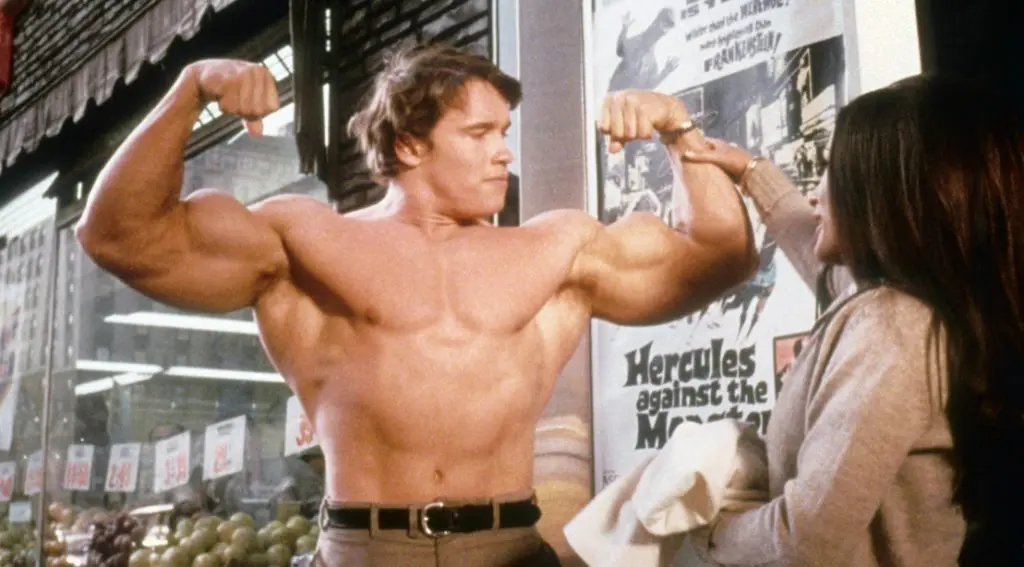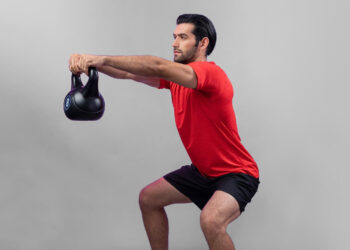Tabata, a high-intensity interval training (HIIT) method, involves 20 seconds of maximum effort exercise followed by 10 seconds of rest, repeated for 4 minutes. The aim should be to reach complete exhaustion by the seventh or eighth round.
Tabata is much different than your typical gym workout, which involves conventional weight training and cardio. As a veteran CPT, Tabata training is my go-to for clients aiming to lose body weight.
It’s super intense, but if you want to significantly improve your aerobic and anaerobic capacity while building muscle and burning fat, then look no further.
A Frontiers in Physiology study found that Tabata training was highly effective in improving cardiorespiratory fitness, body fat, some cardiometabolic health outcomes, and habitual physical activity. (1)
What Is Tabata?
Tabata is a form of high-intensity interval training made popular by Izumi Tabata, Ph.D., at the National Institute of Fitness and Sports in Tokyo; although, he didn’t actually create this program. Irisawa Koichi, who was the head coach of Japanese Olympic Skating, developed the training protocol.
Read also Full Body HIIT Workout!
Level Up Your Fitness: Join our 💪 strong community in Fitness Volt Newsletter. Get daily inspiration, expert-backed workouts, nutrition tips, the latest in strength sports, and the support you need to reach your goals. Subscribe for free!
He wanted to test the training protocol on some athletes and enlisted Tabata to determine whether or not it was effective.

It’s a fast-paced form of training that essentially offers all the benefits of fitness, but each session is performed in a timed format.
Each workout is four minutes in total but you’ll do eight 20-second intervals of hardcore training with 10 seconds of rest in between each interval.
So, it’s pretty much a full-body workout performed in four minutes…
“Originally I thought this type of training was just for speed skaters or other highly motivated athletes because it is very painful and tiring,” said Izumi Tabata.
“However, I found that there were groups of people interested in building muscle and therefore doing short high-intensity exercises that trained their muscle, but not those exercises that improved their aerobic training.
When this regimen came along, they began to realize they could train both at the same time.”
There are many options with Tabata and we’ll explain them below…
Benefits of Tabata Exercises
Combining effective movements with intensity and short rest periods will result in gains! And that’s what Tabata is. It can also save you time and allow you to get a great workout in a very short period of time.
Benefits you can expect include:
Muscle growth

Hypertrophy (muscle growth) is one side effect of Tabata training. You’ll either do bodyweight training/plyometrics or weight training for each four-minute session. And resistance training is obviously conducive to gains in muscle.
As you progress, you can increase the amount of weight used, or you can turn up the intensity a bit more.
Improved endurance
Research shows Tabata-style training (HIIT) to increase aerobic capacity, similar to moderate-intensity continuous training, but HIIT also increases anaerobic capacity by about 28%. (2)
High-intensity training is a popular method in general because it really does burn a lot of calories while offering the benefit of stimulating the muscle in a very short period of time.
Fat and weight loss
The more calories you can burn, the more you’ll be likely to lose weight and/or burn fat. It takes approximately 3,500 calories burned to lose one pound, and you’ll have to track your calories to ensure you’re meeting your requirements. (3)
Use our calorie calculator to determine your recommended daily caloric intake.
According to a study, 4 minutes of HIIT burns approximately 54kcals. But honestly, the amount you burn depends on your body weight and intensity during exercise. (2)
Boosts insulin response and can prevent type 2 diabetes
Insulin sensitivity is crucial for blood sugar level regulation. Regular Tabata workouts can enhance the body’s insulin response, which can be pivotal in managing and preventing type 2 diabetes, a condition characterized by insulin resistance.
A study published in Revista médica de Chile found that Tabata training significantly improved health outcomes, including maximal oxygen uptake (VO2 max) and fasting insulin levels. (4)
Furthermore, Tabata training improves cardiovascular health, which can also help lower blood pressure. The intense physical activity helps strengthen the heart, enabling it to pump blood more efficiently, thus reducing the force on the arteries and consequently lowering blood pressure. This is particularly beneficial for individuals dealing with hypertension. (5)
Getting Started with Tabata Workouts
As a certified personal trainer, I’m here to guide you through the essentials of starting with Tabata workouts, ensuring your training sessions are safe and effective and you can track your progress tangibly.
Ideal Exercises for Tabata Sessions
The beauty of Tabata training lies in its versatility and adaptability. Ideal exercises for Tabata sessions should be high-intensity, compound movements that engage multiple muscle groups. Some of my top recommendations include:
- Squats: A foundational movement engaging the core, glutes, and lower body. I recommend advanced excisers opt for weighted squats, while newbies should stick with the bodyweight version.
- Burpees: These full-body exercises increase heart rate and build strength. Test your endurance and skills with pull-up burpees or bar-facing burpees.
- Box Jumps: One of the best exercises to build explosive lower body strength. As you gain more experience, use a taller box. I recommend rookies use a soft plyo box to avoid the risk of scraping their shins.
- Mountain Climbers: Great for core strength and cardiovascular endurance. Beginners can perform this exercise with their hands on an elevated surface like a flat bench. Conversely, advanced exercisers can perform this exercise wearing ankle weights.
- Jumping Lunges: A plyometric exercise that develops leg strength and agility. Wear a weighted vest during this exercise to challenge yourself. Land with soft knees to minimize the impact on your joints.
Remember, the key is intensity. Perform each exercise with a maximal effort to reap the full benefits of Tabata training.
Tips for Beginners to Safely Engage in Tabata Workouts
Safety is paramount, especially for beginners. Here are some tips to ensure a safe start:
- Start Gradually: If you’re new to high-intensity training, begin with fewer cycles and gradually increase as your fitness improves. Work with a certified professional to design a customized training plan for your needs.
- Proper Form is Crucial: Don’t compromise form in pursuit of intensity. Incorrect technique and using more weights than you can comfortably handle increases the risk of injury. Check your ego at the door before entering a gym.
- Warm-Up and Cool-Down: Begin each session with a dynamic warm-up and end with a cool-down to prevent injuries and aid recovery. Your warm-up routine should mainly include dynamic stretches, whereas the cool-down can combine static and dynamic stretches.
- Listen to Your Body: Push your limits, but be mindful of your body’s signals. Overexertion can be counterproductive. Feel free to take a day off from training if you feel exhausted.
Only healthy individuals should do Tabata training. Very high-intensity workouts can have a negative effect on people who have heart issues and even those not used to such hardcore exercise.
If you’re healthy, just make sure to start slow until you’re training at full intensity.
Level Up Your Fitness: Join our 💪 strong community in Fitness Volt Newsletter. Get daily inspiration, expert-backed workouts, nutrition tips, the latest in strength sports, and the support you need to reach your goals. Subscribe for free!
People with pre-existing medical issues should get their doctor’s clearance before starting a new exercise regimen.
Getting a medical screening done for any underlying medical issues is also a good idea if you’ve never been diagnosed with a health condition but regularly face trouble exercising.
How to Measure and Track Progress
Tracking progress in Tabata training can be incredibly challenging and motivating. Here’s how you can do it effectively:
- Track Repetitions: Note the number of repetitions you complete in each 20-second burst. Over time, you should see this number increase. Begin each training session with a repetition goal. However, you should not compromise your training form trying to beat the rep target.
- Monitor Heart Rate: A heart rate monitor ensures you’re working at high intensity. Aim for 80-90% of your maximum heart rate during the work phases. A higher heart rate is key to improving your cardiovascular fitness and burning more calories. Most fitness trackers have a built-in heart rate sensor. That said, chest straps deliver the most accurate heart rate readings.
- Record Your Recovery Rate: Observe how quickly your heart rate decreases during rest periods. A faster recovery rate over time indicates improved cardiovascular fitness. Conversely, you might be in the overtraining zone if your heart rate takes too long to recover. If this is the case, take some time off training and allow your body the much-needed rest and recovery.
- Keep a Workout Journal: Contrary to what most people think, you don’t need to carry a notebook to the gym to journal your workouts. You could do it in your phone’s notes app. Document each workout, noting exercises, repetitions, and any improvements in performance or endurance. This will not only track your progress but also keep you motivated.
As you embark on your Tabata journey, remember that consistency is key. Regular sessions, a balanced diet, and adequate rest will lead to remarkable improvements in fitness, strength, and endurance. Embrace the challenge, and let the transformative power of Tabata workouts propel you towards your fitness goals.
Common Mistakes and Misconceptions in Tabata Training
As an industry veteran, I can vouch for the fact that Tabata workouts are among the most misunderstood in the health and fitness space.
Some think Tabata workouts are a form of cardio training, whereas others think they are a close cousin to Pilates.
Furthermore, I have seen people skew the fundamentals of Tabata training to make the workouts more comfortable. In doing so, these folks not only reduce the effectiveness of the workouts but also increase the risk of injury.
To get the most out of Tabata training, you must perform them as Dr. Izumi Tabata had originally designed them.
Below are the most common mistakes and misconceptions around Tabata training. Let’s clear the air to ensure more people add Tabata workouts to their training regimen:
Mistake #1: Confusing Intensity with Speed
Many enthusiasts equate Tabata with simply doing exercises as fast as possible. This is a fundamental error. Tabata is about high intensity, not high speed. Intensity refers to the level of effort relative to your maximum capacity. Doing exercises too quickly can lead to poor form, reduced effectiveness, and increased injury risk. Remember, it’s about quality, not just speed.
Mistake #2: Inadequate Warm-Up
Given the intense nature of Tabata workouts, skipping a proper warm-up is a recipe for injury. A dynamic warm-up of at least 5 to 10 minutes is crucial to prepare your muscles and cardiovascular system. This prep time isn’t just physical – it’s mental, too, getting you in the right headspace for the challenge ahead.
Mistake #3: Overtraining
Tabata’s allure often leads to the misconception that more is better. However, due to its intensity, Tabata should not be a daily routine. Overtraining can lead to exhaustion, decreased performance, and even injury. Ideally, incorporate Tabata 2-3 times weekly into your routine, allowing ample recovery time.
Misconception #1: Tabata is for Everyone
A common myth is that Tabata fits all fitness levels. The truth is that its high-intensity nature makes it more suitable for those with a solid fitness base. Beginners should start with less intense interval training and gradually work up to Tabata to avoid overwhelming their bodies.
Misconception #2: Tabata is Just Cardio
While Tabata significantly boosts cardiovascular health, it’s not just a cardio workout. When performed with resistance exercises, it can also be an effective way to build strength and muscle endurance. Incorporating weights or bodyweight resistance exercises can provide a more balanced fitness approach.
Misconception #3: Any Exercise Works for Tabata
Not all exercises are suitable for Tabata. The key is to choose movements that you can perform safely at high intensity and that engage multiple muscle groups. Complex movements that require a lot of coordination or technical skill might not be ideal when fatigued.
In conclusion, understanding and addressing these common mistakes and misconceptions in Tabata training is crucial for maximizing its benefits while minimizing risks. As with any fitness program, individual needs and capacities should be considered. Remember, the path to fitness is a journey, not a sprint — even when that journey includes intense intervals like Tabata.
Constructing a Tabata Workout
So to devise an effective workout for four minutes, you’ll have to choose a few exercises which are most convenient and which you can perform completely for the duration of the session.
You can choose to do weighted exercises or bodyweight movements and the number of exercises you choose to complete are completely up to you.
So, you can choose one exercise or many and the latter is preferred to train several muscle groups in a single workout. So, for instance, you can do push-ups, pull-ups, and leg lifts all in one four-minute workout.
But you can use as many exercises as you please in any style during the eight rounds.
Tabata Sample Workout:
Each round will equal one minute. You’ll perform four rounds to equal four minutes in total.

Round 1:
- Push-ups
- Pull-ups
Do push-ups for 20 seconds then rest 10 seconds. Then do pull-ups for 20 seconds and rest 10 seconds. Alternate these two exercises until you’ve gone for four rounds. This will equal one minute.
Round 2:
- Bodyweight squats
- Bodyweight Lunges
Do squats for 20 seconds then rest 10 seconds. Then do lunges for 20 seconds and rest 10 seconds. Alternate these two exercises until you’ve done all four rounds.
Repeat rounds 1 and 2 to complete the four-minute routine.
What About Training Frequency and Recovery?

Treat Tabata training like you would any other routine. Do a workout two-three times per week and then rest 48-72 hours in between your sessions.
Seeing as to how intense Tabata-style training is, you want to make sure you’re not overdoing it by training too frequently. Proper like a high carb meal before a workout is a good idea as well to ensure you have plenty of glycogen stores to fuel your intense sessions. (5)
Staying sufficiently hydrated is also essential for health and strength as just a few percent loss in body mass can decrease strength by 2%. (6)
Final Thoughts
Tabata is extremely effective when performed as it’s intended to be.
“People need to realize that to get into shape, to really reap the benefits of Tabata training, it’s the intensity part that gets you into shape, not the four minutes,” explained John Porcari, Ph.D., head of the Clinical Exercise Physiology Program at the University of Wisconsin, La Crosse.
So, if you follow a training protocol similar to the one laid out above, you no doubt see great results. Or, you could adjust the routine to your preference.
Just make sure you’re in good health before attempting any intense training program, and always build up the intensity as opposed to jumping straight in.
References
- Lu, Y., Wiltshire, H. D., Baker, J. S., Wang, Q., & Ying, S. (2023). The effect of Tabata-style functional high-intensity interval training on cardiometabolic health and physical activity in female university students. Frontiers in Physiology, 14. https://doi.org/10.3389/fphys.2023.1095315
- Emberts T, Porcari J, Dobers-Tein S, Steffen J, Foster C. Exercise intensity and energy expenditure of a tabata workout. J Sports Sci Med. 2013;12(3):612-613. Published 2013 Sep 1.
- Mayo Clinic Staff. Counting calories: Get back to weight-loss basics. Mayo Clinic. https://www.mayoclinic.org/healthy-lifestyle/weight-loss/in-depth/calories/art-20048065. Published January 18, 2023. Accessed [01/05/24].
- Lu Y, Wiltshire HD, Baker JS, Wang Q, Ying S. The effect of Tabata-style functional high-intensity interval training on cardiometabolic health and physical activity in female university students. Front Physiol. 2023 Feb 27;14:1095315. doi: 10.3389/fphys.2023.1095315. PMID: 36923290; PMCID: PMC10008870.
- Olea MA, Mancilla R, Martínez S, Díaz E. Entrenamiento interválico de alta intensidad contribuye a la normalización de la hipertensión arterial [Effects of high intensity interval training on blood pressure in hypertensive subjects]. Rev Med Chil. 2017 Sep;145(9):1154-1159. Spanish. doi: 10.4067/s0034-98872017000901154. PMID: 29424402.








